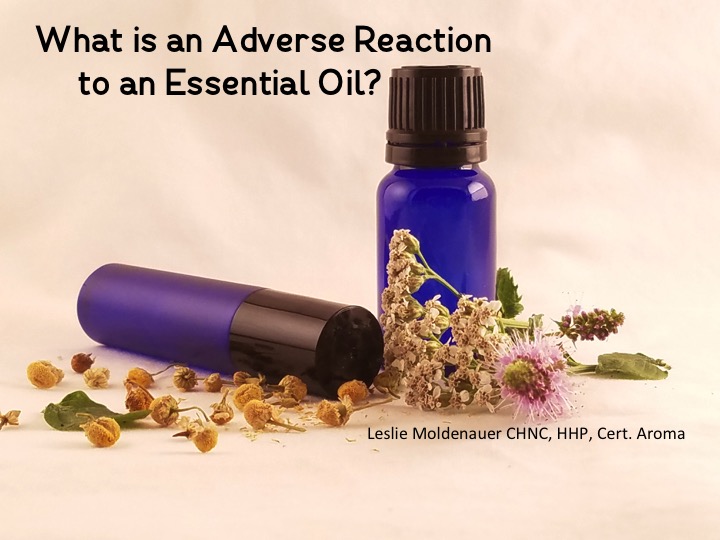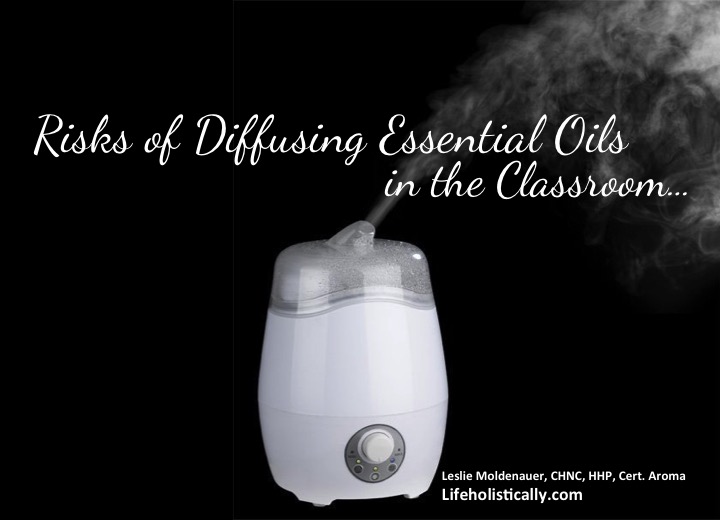
by Leslie Moldenauer | | Essential Oils
What is an adverse reaction to an essential oil? Would you know what to do if you or your child had an adverse reaction to an essential oil or oil blend? Do you know what an adverse reaction looks like? I will be covering a few of those here in hopes to make you more aware of what that might look like, and what to do if it happens. When we use essential oils, safety has to be the first thing we keep in mind.
First and foremost, this article is not written to scare or instill fear, but to make you more knowledgeable. I want to empower you to use them properly and know what to look for in the rare case there is a reaction. It is important to note, if you are following basic safety instructions, the likelihood of an adverse reaction is greatly reduced.
Skin Reactions
The first thing to look out for when using essential oils topically is skin reactions.
-Skin irritation, which is a direct result of contact with the skin and is localized to where the oil was applied. Once the material is removed, healing occurs. Removal is best done with a carrier oil such as almond, jojoba, or milk. Healing may not occur immediately, but you should see improvement after proper removal.
-Skin sensitization is a more serious reaction that is systemic (affecting the entire body or organism), involving the immune system called sensitization.
According to Dorene Petersen, president of the American College of Healthcare Sciences (ACHS):
“Sensitization occurs once the offending substance has penetrated the skin, been picked up by proteins in the skin, and mediated by the IgE response that produces histamine and other irritants” [1].
This is an allergic reaction that begins at the site of application but quickly spreads to the whole body. If the immune system response is activated, you likely will not be able to use the oil, or constituent in the oil again (the constituent can occur in multiple oils).
If this happens to you please seek medical attention immediately. Save the bottle of oils for the medical staff, to help them to understand what they are dealing with. (Poison Control (800) 222-1222…24 hours a day)
–Phototoxic reactions can occur from a specific list of oils. This can occur when certain essential oil constituents on the skin react when exposed to the sun (ultraviolet light). Tanning beds also need to be avoided. This can result in general redness and burning of the skin, changes in melanin of the skin, and there is even potential for a more serious reaction such as chemical burns. These oils can be used on the skin, but utilize caution by not going out into the sun for 12-24 hours after exposure. If you follow this simple safety precaution, you will never have to deal with this type of reaction.
**It is important to note that this applies to the area of skin where the oil was applied, not your body as a whole.
Here is a list of oils that should be used topically with caution, and their maximum use levels according to the International Fragrance Association (IFRA) standards [2]:
Angelica Root (Angelica archangelica) 0.8%
Bergamot (Citrus bergamia) 0.4%
Bitter Orange (Cold/Expeller Pressed) (Citrus aurantium) 1.25%
Cumin (Cuminum cyminum) 0.4%
Grapefruit (expressed) (Citrus paradisi) 4.0%
Lemon (Cold/Expeller Pressed) (Citrus limon) 2.0%
Lime (Cold/Expeller Pressed) (Citrus aurantifolia) 0.7%
Mandarin Leaf (Citrus reticulate) 0.17%
Rue (Ruta graveolens) 0.15%
Taget (Tagetes minuta) 0.01%
*If you have a phototoxic reaction such as a chemical burn, seek out the care of a medical professional to reduce permanent effects.
Diffusing Essential Oils
Essential oil diffusers disperse the essential oil into the air in tiny droplets. Robert Tisserand recommends diffusing times of 30-60 minutes, or 30 minutes on and 60 minutes off [3]. If you are diffusing in a small room, make sure to have proper ventilation. I think Tisserand’s recommendations may be generous when looking at small children, therefore, I will go one step further to say that if you are diffusing for a small child, 15-20 minutes on and 60 minutes off will be more than sufficient for them. If you decide to diffuse for a baby, six months or older, 10 minutes will likely be just enough.
In order to explain possible reasons for the recommended times, let’s talk a little bit about our sense of smell, or our olfactory system.
Dorene Petersen of the American College of Healthcare Sciences (ACHS) states that:
“Our sense of smell goes through five stages, those are: detect, transmit, perceive, analyze, and store. These stages cycle incredibly fast. The reception area of our olfactory system is called the olfactory epithelium. The olfactory epithelium is the size of a small postage stamp in each nostril, and is packed with an impressive 40 million sensory neurons, capable of detecting .0000000013 of an ounce of a scent in a single breath of air” [4].
Our olfactory system is incredibly efficient, obtaining the therapeutic benefits of these amazing oils happens quickly. To receive maximum benefit and not waste your precious oils, follow the diffusing times recommended above.
When we inhale too much of a good thing, we can have adverse effects. Tisserand stated in his book, Essential Oil Safety 2e, “prolonged inhalation (more than about 30 minutes) of concentrated essential oil vapors (e.g., steam inhalation or direct from a bottle) can lead to headaches, vertigo, nausea and lethargy” [5].
You can also experience an overall feeling of being unwell marked by malaise or disorientation, or even heartburn. I get heartburn from diffusing cinnamon (Cinnamomum zeylanicum).
Concentrated essential oil vapors are considered direct inhalation. What is considered direct inhalation and what is considered passive inhalation?
Direct Inhalation
Steam inhalation (steam tent or steam bowl)
Handheld nebulizer
Directly from the bottle
Inhalers (aromastick)
On hands, cupping the nose
On a cotton ball or other material right up to the face
I recommend avoiding these methods of use under the age of five.
Indirect/Passive Inhalation
Diffusers (atomizers, ultrasonics, nebulizers, fan diffusers, aromastone)
You can greatly reduce risk by practicing safe diffusion times, matching up the right diffuser for your space, and being mindful of adverse reactions. Remember, when you have babies, toddlers, etc., they are not likely going to be able to tell you if they are having symptoms of overuse. They are counting on you to make the best choices you can.
*For more information on safe diffusing, please refer to Essential Oil Safety 2e by Robert Tisserand and Rodney Young.

Internal Use
At times online and in social media, internal use is recommended quite casually without much respect for their true power. In my opinion, if you are not trained in the internal use of oils (Aromatic Medicine) or are being helped by someone who is, this is a risky thing to do. Why would I say this? Often times the methods that are being shared are not at all the way that they should be used. Let me explain…
The liver is not equipped to handle this amount of aromatics. You may have heard in certain circles that essential oils are pure and this is perfectly safe. Essential oils are still chemicals. The liver’s job is to recognize foreign substances such as these and remove them as quickly as possible. A good analogy here is water in a glass. Begin pouring water in, once the glass has hit maximum capacity the water overflows. The liver is no different.
Oral dosing can interfere with medication or aggravate other medical conditions. You may hear something like “our oils are pure therapeutic grade and are safe for internal use” or “certain oils are GRAS” (generally recognized as safe for consumption), but this applies to consuming in food (food additives), not in water.
Internal usage does have its time and place, but you MUST know what you are doing…or at the very least, consult with someone who has been properly trained.
Here is another great reference to learn more about internal use.
Interference with Medications
Some oils are contraindicated for use when taking certain medications. These oils can be problematic for those taking diabetes medication, heart medication, cancer medication, and medications via patches just to name a few.
If you are sharing the benefits of oils to others, are you aware of the specific contraindications? If so, are you asking your neighbor or friend what kinds of medications they are taking? The majority (not all) of these warnings are more of a concern when taking the oils internally, but if you are unaware, this can really be a concern.
*For more information on medications that can interfere with essential oil use, please refer to Essential Oil Safety 2e by Robert Tisserand and Rodney Young.
Closing
As I mentioned above, when you follow proper safety measures, you are much less likely to experience adverse affect. If you are unsure of something, please feel free to reach out to me anytime at Lifeholistically@gmail.com

References
[1] Petersen, D. (2012) Aroma 101-sensitization. American College of Healthcare Sciences (p 50)
[2] IFRA standards. Retrieved from http://www.ifraorg.org/en-us/standards-library/s/phototoxicity#.V9VaSpMrJn4,
[4] Peterson, D. (2012) Aroma 101. American College of Healthcare Sciences
[3] [5] Tisserand, R., Young, R. (2014) Essential Oil Safety (2nd Ed)
BEFORE YOU GO! Remember to sign up for my FREE Facebook group! Hang out with me and THOUSANDS of other Essential Oil lovers looking to learn, click on to join Real Essential Oil Education Group!
Check out my FREE offer below!
Please note that I am not a medical practitioner. The content of this website is provided for general informational purposes only and is not intended as, nor should it be considered a substitute for, professional medical advice. Do not use the information on this website for diagnosing or treating any medical or health condition. If you have or suspect you have a medical problem, promptly contact your professional healthcare provider. By using this website, you assume full responsibility and liability for your own actions.
Essential Oils-Uncovering Fact From Fiction
Why Is It That Essential Oils Don’t Always Work

by Leslie Moldenauer | | Essential Oils
The risks of diffusing essential oils in the classroom. If we take into consideration the number of germs that are passed back and forth at school, it is not a surprise that some teachers have considered diffusing essential oils in the classroom. For those with minimal education, this may seem like a great solution to keeping sickness at bay and to keep attendance up, but it comes with a significant amount of risk. Many are told that essential oils are completely natural and safe for everyone, but this is not always the case. There are many things that need to be considered when diffusing in a classroom full of children with a variety of different health constitutions. The liability in this type of situation needs to be looked at closely.
First things first, I know many teachers personally and have had the pleasure of having some wonderful teachers for my two boys over the years. I can say without a doubt, that they hold your child’s well-being very close to their heart. They would not want to do anything to harm a child.
I hope to clear up the variety of possible issues of the practice of diffusing in the classroom so that parents, teachers, and faculty can understand the safety issues and the risks. I hope to assist them and you so that everyone can make informed decisions for the well being of our children.
Essential Oil Home Use
Essential oils are a beautiful complementary modality. They come from plants but even though they have the potential to assist the body in doing what it does best, they do not come without risk. The home user can utilize essential oils after a little bit of research. The “basics” of aromatherapy can be researched on the Internet. The more in-depth topics, however, need more scientific, evidence-based research.
When looking on the Internet for research, many times the method of application and safety is not covered, so in cases of someone searching for information with limited knowledge of the topic, it can be a precarious situation. The recommendations given online come from a place of wanting to help others, but many times, they miss the mark.
Essential Oil Classroom Use-The Risks
One of the many reasons for more scientific research of essential oils is they do not come without risk, especially for children. A classroom has an average of 20 children. Some of which may be immune-compromised, taking numerous medications, have allergies, chemical sensitivities, respiratory issues such as asthma, an increased risk of seizures, autoimmune diseases and more. A teacher could not possibly know how one seemingly innocuous essential oil could react among those 20 children. The reactions for just one child could change from day to day as well. Aromatherapists know when working with clients what works for one person may not work for another. It may be offensive or have the completely opposite reaction/effect.
Asthma
There are numerous oils that should not be used with children who have asthma. Asthma and essential oils are very tricky. The triggers for one person are completely different to the next. Even seasoned aromatherapists recommend extreme caution when trying essential oils for clients with asthma. I myself, insist that an asthma sufferer have their inhaler handy when trying a particular oil or oil blend for the first time as well as the 3rd, 10th, and 50th time. Asthma can be a life-threatening situation, and many oils, as well as other aromas in the environment, can trigger it.
ADD, ADHD, Autism
Another health situation that needs great consideration is ADD, ADHD, and autism. A great example here is the essential oil of Lavender Lavandula angustifolia. It is a known phenomenon by aromatherapists that many with ADHD have a manic type reaction to lavender rather than what should be a sedating one. Here is an informative article that was written by educator Sylla Sheppard-Hanger of the Atlantic Institute of Aromatherapy that covers the topic in more detail.
Chemical Sensitivities
Chemical sensitivities are becoming more and more common in society. The initial cause is not fully understood, but various chemicals in the environment can be a trigger it. Many chemical components in essential oils are also found in the environment. Let’s look at Limonene as an example. Limonene is found in many of the citrus essential oils and is also found in the environment in degreaser, Goo-Gone, wood finisher, and other items that can be found in the household. Many foods contain minimal amounts of essential oil constituents. Some may be surprised to know that cinnamaldehyde found in cinnamon and cassia oils (think popular anti-germ blends) is found not only in household cleaning products and candles, but is also in cinnamon bread, cereals, cookies, puddings, applesauce, and fruit juices in the supermarket (1).
Essential oil constituents cross over into common household products, home goods, and foods in many more instances than these. For those that have chemical sensitivities, the day to day can be very challenging. Some of the possible symptoms of chemical sensitivity are headaches, nausea, dizziness, rashes, respiratory difficulty (including asthmatic episodes), and cognitive dysfunction (2). The more immune-compromised a person is, the more likely they are to have these sensitivities.
Unfortunately, there are many other chemicals in the classroom that can be an issue as well. Limiting exposure to the toxic chemicals of conventional household cleaning products can be done. Using essential oils for cleaning hard surfaces is a great idea, ONLY in the evening after the children have gone home for the day. Here is a great resource for you from the Aromatic Wisdom Institute, to help you to clean with essential oils safely.
Seizures
There are a few oils that are not recommended around children (or adults) that have a seizure disorder or a predisposition to them. Essential oils with high amounts of camphor are a known issue, those include but are not limited to: Ho leaf CT camphor, Spanish lavender, wormwood, sage, basil, spike lavender, rosemary CT camphor (camphor is not the only constituent that has the potential to precipitate a seizure). Various species of eucalyptus, although not common, has the potential to precipitate a seizure when used near the face of a child under 10 years of age (3).
These situations are rare but have happened in children, so it is important to understand the risk.
Liability
Now that I have covered a few of the various health issues that could make diffusing essential oils in the classroom risky, let’s briefly cover the liability of doing so. Parental consent for every child is a must. Those parents must be told which oils will be diffused, and what those risks are for certain children. (As you can see by what I covered above that is not going to be easy). Essentially, school boards must be the ones to come up with guidelines and policies for such a practice.
If parental consent is not obtained before classroom diffusing and something happens to a child, the liability is great for the teacher and the school district. Sadly, there are some instances, (speaking from experience) where the principal of a school may not even be aware of the practices of the teacher. In this particular instance, the teacher thought that she was doing something that would benefit the children. The school district already had a rule in place stating there are no diffusing essential oils in the room with children present so it was handled quickly.
Diffusing Times
Even though we now know that diffusing in the classroom is not the best practice for everyone’s safety, I want to briefly cover safe diffusing. Robert Tisserand states that 30-60 minutes of diffusion followed by a 60-minute break is best (4). (I typically recommend half this amount of time for a child). Extended diffusing can overwhelm the senses.
In order to explain the possible reasons for this, let’s talk a little bit about our sense of smell, or our olfactory system. According to Dorene Petersen of ACHS, “Our sense of smell goes through five stages, those are: detect, transmit, perceive, analyze, and store. These stages cycle incredibly fast. The reception area of our olfactory system is called the olfactory epithelium. The olfactory epithelium is the size of a small postage stamp in each nostril and is packed with an impressive 40 million sensory neurons, capable of detecting .0000000013 of an ounce of a scent in a single breath of air” (5). Our olfactory system is incredibly efficient, obtaining the therapeutic benefits of these amazing oils happens quickly. To receive maximum benefit and not waste your precious oils, follow the diffusing times recommended above.
Another important myth to dispel is that diffusing essential oils rids the air of the VOC’s present. This is not factual. The most effective methods in counteracting VOC’s in the home is a high-quality air filter, houseplants, and making sure you allow the fresh air in as much as possible.
A Possible Alternative
A personal inhaler is an option for a child to take to school (with permission). They can be helpful for a variety of reasons such as allergies, stuffy nose, or to help with anxiety or improve focus. The personal inhaler’s scent is limited to the user, meaning no other children become exposed to the scent or the vapor. As long as the parent is sure of the safety of their child and they understand they are not to share it, the risk is removed for the teacher, faculty, or the other children in the room.
In Conclusion
As you can see, essential oil use must be evaluated for each individual, circumstance, and the environment. These are general guidelines that do not mean definitive results in all cases. This article was not written to instill fear, but to respect their uses and limitations.

References:
(1) Cinnamaldehyde content in foods determined by gas chromatography-mass spectrometry
(2) Multiple Chemical Sensitivity. Retrieved from
http://www.webmd.com/allergies/multiple-chemical-sensitivity#1
(3) (4) Tisserand, R., Young, R. (2014) Essential Oil Safety (2nd Ed)
(5) Petersen, D. (2012) Aroma 101
Resources from above and more!
Extreme Chemical Sensitivity Makes Sufferers Allergic to Life
Green Cleaning with Essential Oils
Lavender: It’s not always calming
Personal Inhaler
Like so many practices in life I encourage you to become educated on the proper use of essential oils. When using them, please do so cautiously, understanding that there is often misinformation on the Internet. You can be assured that I support only educated and proven resources. While essential oils should not be feared they should be respected and used properly to ensure the safety of the individuals using them. Please note that I am not a medical practitioner. The content of the website is provided for general informational purposes only and is not intended as, nor should is be considered a substitute for, professional medical advice. Do not use the information on this website for diagnosing or treating any medical health condition. If you have, or suspect you have a medical problem, promptly contact your professional healthcare provider. By using this website, you assume full responsibility and liability for your own actions.
BEFORE YOU GO! Remember to sign up for my FREE Facebook group! Hang out with me and THOUSANDS of other Essential Oil lovers looking to learn, click on to join Real Essential Oil Education Group!
Check out my FREE offer below!
Essential Oils-Uncovering Fact From Fiction
Safety surrounding diffusing essential oils







